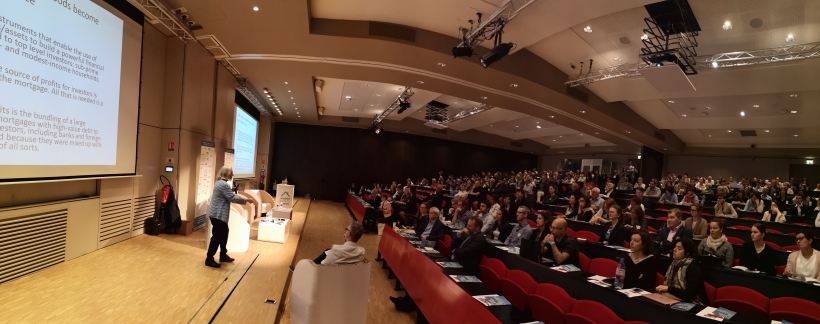Making Europe’s cities affordable
What can be done?
Lyon, 13 June 2019 | Social, Urban, Economy
What’s happening to housing in our cities? Why has it become so hard to access affordable quality housing in conurbations of all sizes? And what can we do about it?
By Eddy Adams*
Last week, at Housing Europe’s Annual Conference in Lyon, Saskia Sassen shared her compelling interpretation of what’s going on. She referred to Dark Pools of finance, and conjured images of armies of bright young physicists writing algorithms in large open plan Goldman Sachs offices. On this new front line they are busily engaged in the alchemic transformation of urban property into fields of assets.
The net effect is a revolution in property ownership where ordinary people are squeezed out. At the same time our cities become rendered, fake and devoid of communities. This urban emptiness is most evident at night, with half empty buildings resembling Christmas trees with most of their lights missing.
London tops Professor Sassen’s analysis as the city with the highest proportion of foreign property investment. Then in New York we have the Time Warner Centre, where 122 of 192 apartments are owned by shell companies hiding owners’ identity. And that’s just the tip of the iceberg. I went to Lyon from Brno, where people told me that the biggest challenge is affordable housing in the city. This issue is everywhere. Everywhere. Having realised the value of urban property as asset backed securities, footloose investors have widened their scope beyond the mega cities. We are all in their sights now.
Extraction is a word Saskia Sassen likes to use for what’s happening, as the corporate sector strips out the urban property market, repackages it and sells it to the next investor. As Mark Twain perceptively said, many years ago ‘Buy land, they’re not making it any more.“ It is the ultimate finite resource. That’s why, with a burgeoning urban population, and generous tax-laws, the appeal to investors is irresistible.
Channeling Woody Guthrie, the theme of Housing Europe’s event was “This land is whose land?” The question is more pertinent than ever: but what to do? Where to start? The scale and complexity of the challenge can seem so overwhelming that we might conclude this trend is inevitable and unstoppable. But that would be wrong. So where do we start? Here are three key steps.
First, by getting a better handle on the facts. This isn’t easy, due to the opacity and deliberately labyrinthine complexity of the financial world, a demi monde of shell companies and faceless off shore corporations. But the work of Prof Sassen shows that it’s possible, and she’s not alone. Sjoerdje Van-Heerden shared the work of the European Commission’s CiTOWN project which investigates the financialisation of residential housing in Europe.
Second, we need the political will to recognise the problem and to commit to tackling it. No one is saying that this is easy, for no sooner have we understood the issue when it has morphed into something else. Global money moves fast, however, it helps to focus on the effects of these urban trends - widening inequalities, poorer health and reduced levels of social cohesion. It’s also useful to be clear about what cities can do to counter this trend. Actions include increasing the amount of publicly owned land for productive use, the construction of quality affordable housing and support for ways to diversify ownership and renting options.
Third, we take action. And the good news is that all of these initiatives are already happening across Europe. Top of the class is the city of Barcelona, which came away from Lyon with a Responsible Housing Award for its pioneering work. As Councillor Josep Maria Montaner explained, the city’s ambitious strategy includes a shift away from selling land for private residential development, an insistence on 30% of affordable housing in private developments and a commitment to building 535 co-operative housing units by 2025. As in so many urban policy areas, the Catalan capital gives a masterclass in the art of the possible.
But they are not alone. We heard from Celine Di Egidio about the innovative work that SLRB in the city of Brussels is doing to bring back disused sites into public ownership so that they can be repurposed for the benefit of citizens. Across the border in France, Lyon and Lille shared details of their work supporting Community Land Trusts, a concept whose time has come in all parts of Europe and beyond. We also got a chance to hear about Urbact’s work mobilising cities as well as the innovative solutions coming from Urban Innovative Actions. And it’s not just cities getting in on the act. Sarah Boyack gave an insight into Scotland’s commitment to redeploy more than 10,000 hectares of derelict land into productive use by 2025.
We discussed these inspiring resistance stories in France on the 75th anniversary of D-Day. Perhaps this is the point where the tide turns in the battle to reclaim our cities for all those who live in them. Stay tuned to Housing Europe’s work to find out more, and to hear ways to get involved.
* Eddy Adams is urban policy expert and moderator inter alia of the Housing Europe annual conference.

Leave comments